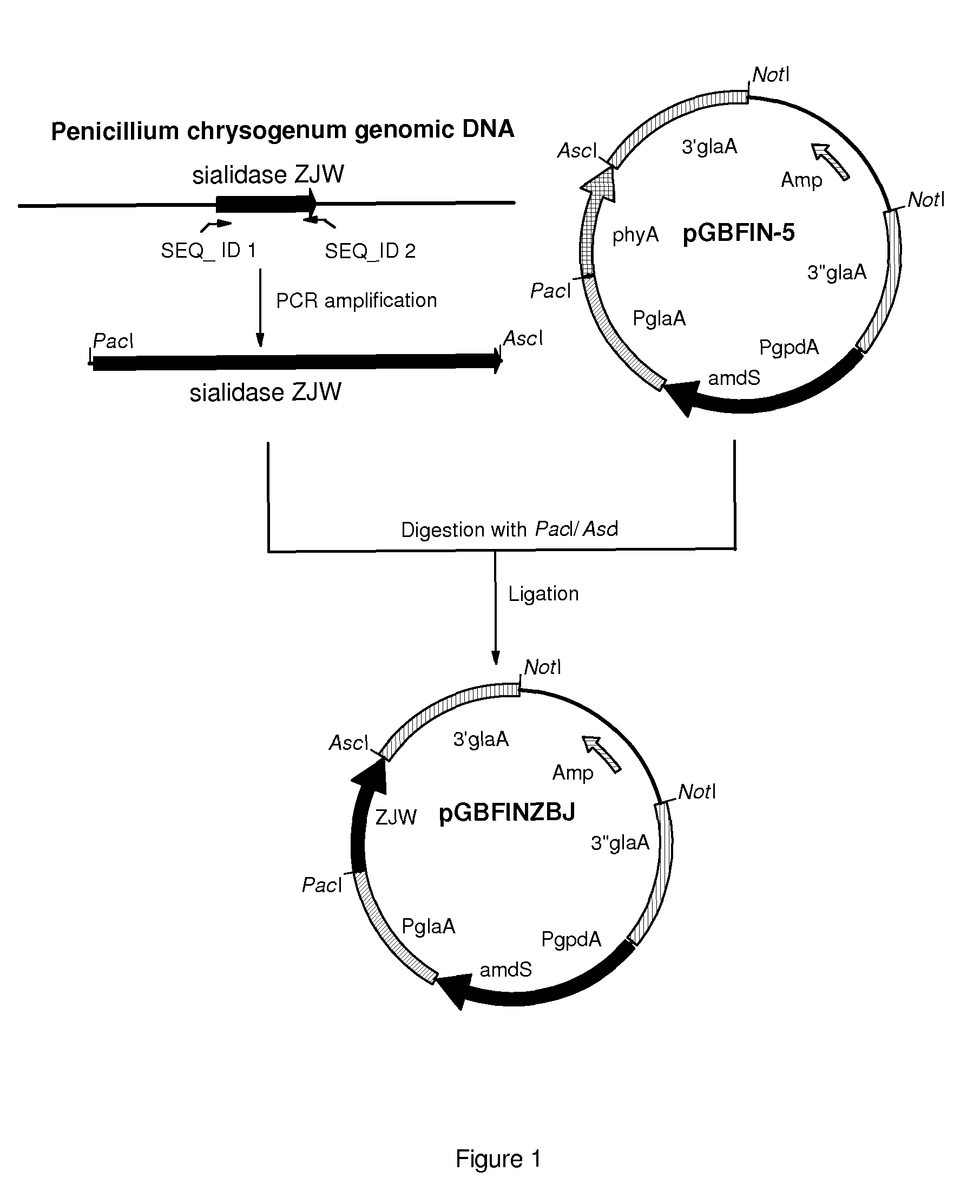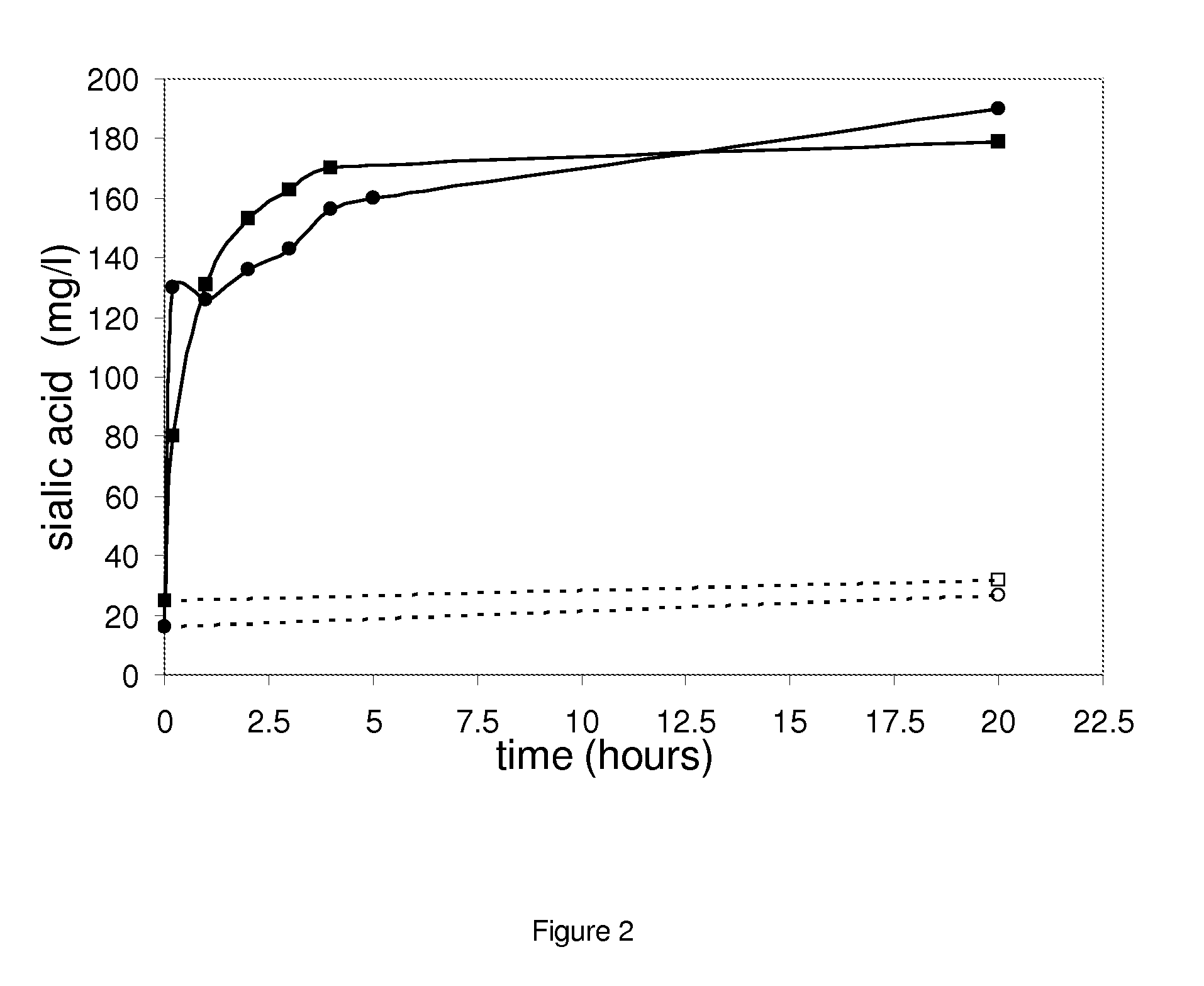Novel prebiotics
a prebiotic and composition technology, applied in the field of novel prebiotic compositions, can solve the problems of difficult chemical synthesis of oligomeric sugars, affecting the health of the organism, and masking can also have a detrimental effect,
- Summary
- Abstract
- Description
- Claims
- Application Information
AI Technical Summary
Benefits of technology
Problems solved by technology
Method used
Image
Examples
example 1
Cloning and Expression of the Sialidase Gene ZJW
[0120]Penicillium chrysogenum strain CBS 455.95 was grown for 3 days at 30 degrees Celsius in PDB (Potato dextrose broth, Difco) and chromosomal DNA was isolated from the mycelium using the Q-Biogene kit (catalog nr. 6540-600; Omnilabo International BV, Breda, the Netherlands), using the instructions of the supplier. This chromosomal DNA was used for the amplification of the coding sequence of the sialidase gene using PCR.
[0121]To specifically amplify the sialidase gene ZJW from the chromosomal DNA of Penicillium chrysogenum strain CBS 455.95, two PCR primers were designed. Primer sequences were partly obtained from a sequence that was found in the genomic DNA of Penicillium chrysogenum CBS 455.95 and is depicted in SEQ ID NO: 1. We found that this sequence has homology with sialidase sequences of Actinomyces and Arthrobacter. However, no homologous fungal sialidases have been described yet. It is therefore surprising that we were able...
example 2
Purification and Characterization of the Sialidase ZJW
[0126]Sialidase was produced via fermentation as described in Example 1. Enzyme activity was measured using the Amplex Red neuraminidase assay kit (obtained from Invitrogen). Culture filtrate (100 ml) was diluted with milliQ-water to a conductivity of 4.8 mS / cm and concentrated to 70 ml by ultrafiltration using a Biomax-10 membrane (obtained from Millipore). The pH was adjusted to 6.0 using NaOH and the sample was loaded on a 5 ml HiTrapQ ion exchange column (obtained from Amersham, 5 ml / min), equilibrated in 20 mM sodium citrate (pH6.0). The flow through of the column, containing the sialidase, was collected and dialyzed against 25 mM Tris, HCl (pH7.0) and loaded on a 5 ml HiTrap Q FF (5 ml / min), equilibrated in the same buffer. The sialidase was present in the flow-through fraction and was collected. The enzyme solution was then dialyzed against 30 mM sodium citrate (pH4.0, buffer A) and applied on a 5 ml HiTrap SP column (obta...
example 3
Liberation of Free Sialic Acid from Milk and Whey
[0127]Free sialic acid can be analyzed by means of reverse-phase HPLC, using fluorescence detection with excitation at 310 nm and emission 448 nm after labelling with DMB compound. This method was recently described in literature (M. J. Martin et al Anal. Bional. Chem, 2007, 387, 2943-29-49) and allowed fast and accurate determination of free sialic contents in samples.
[0128]Milk was reconstituted by using NILAC low heat skim milk powder (NIZO, The Netherlands); whey was obtained from a local cheddar making facility. The milk and whey samples were treated as follows: milk and whey was incubated separately with sialidase ZJW (0.4 U / ml) at room temperature (20-21° C.) and the reaction was terminated at different moments of time by heating the samples in water bath at 95° C. for 5 minutes. A series of several sialidase ZJW concentrations and incubation times were performed. The samples used for HPLC analysis need to be ...
PUM
| Property | Measurement | Unit |
|---|---|---|
| Composition | aaaaa | aaaaa |
Abstract
Description
Claims
Application Information
 Login to View More
Login to View More - R&D
- Intellectual Property
- Life Sciences
- Materials
- Tech Scout
- Unparalleled Data Quality
- Higher Quality Content
- 60% Fewer Hallucinations
Browse by: Latest US Patents, China's latest patents, Technical Efficacy Thesaurus, Application Domain, Technology Topic, Popular Technical Reports.
© 2025 PatSnap. All rights reserved.Legal|Privacy policy|Modern Slavery Act Transparency Statement|Sitemap|About US| Contact US: help@patsnap.com



